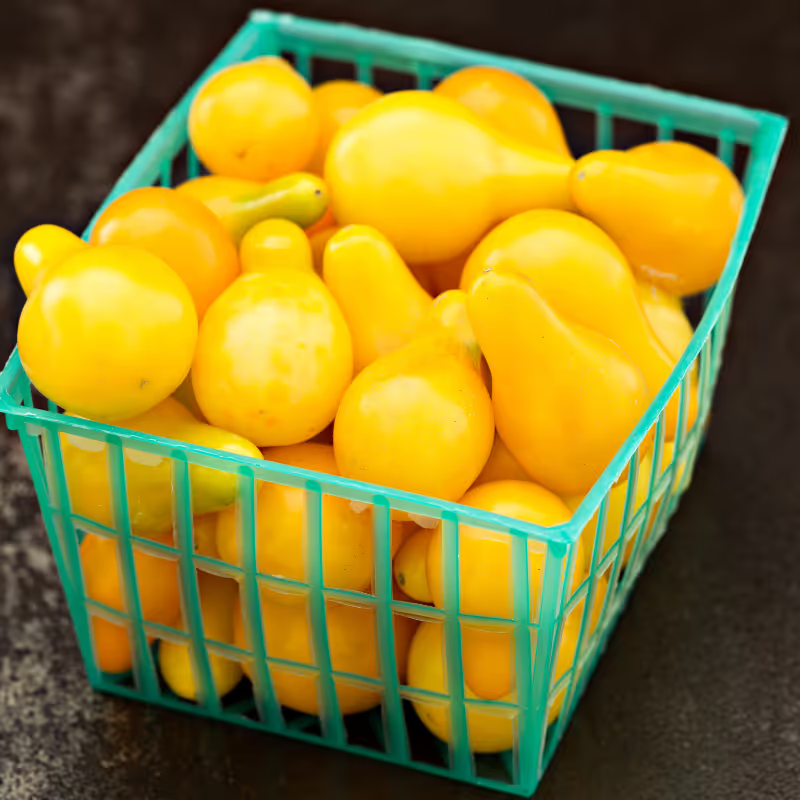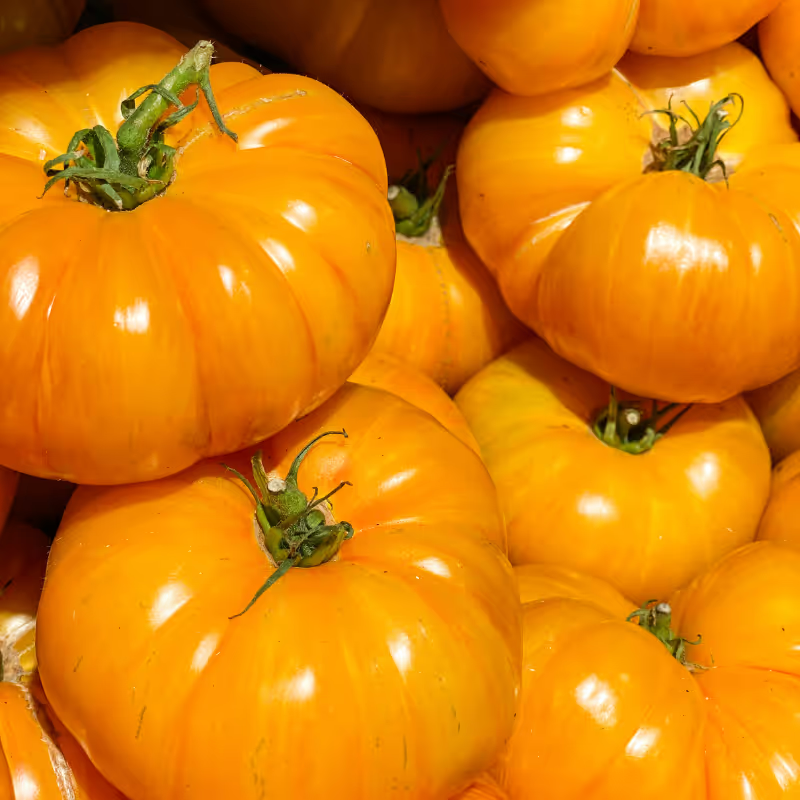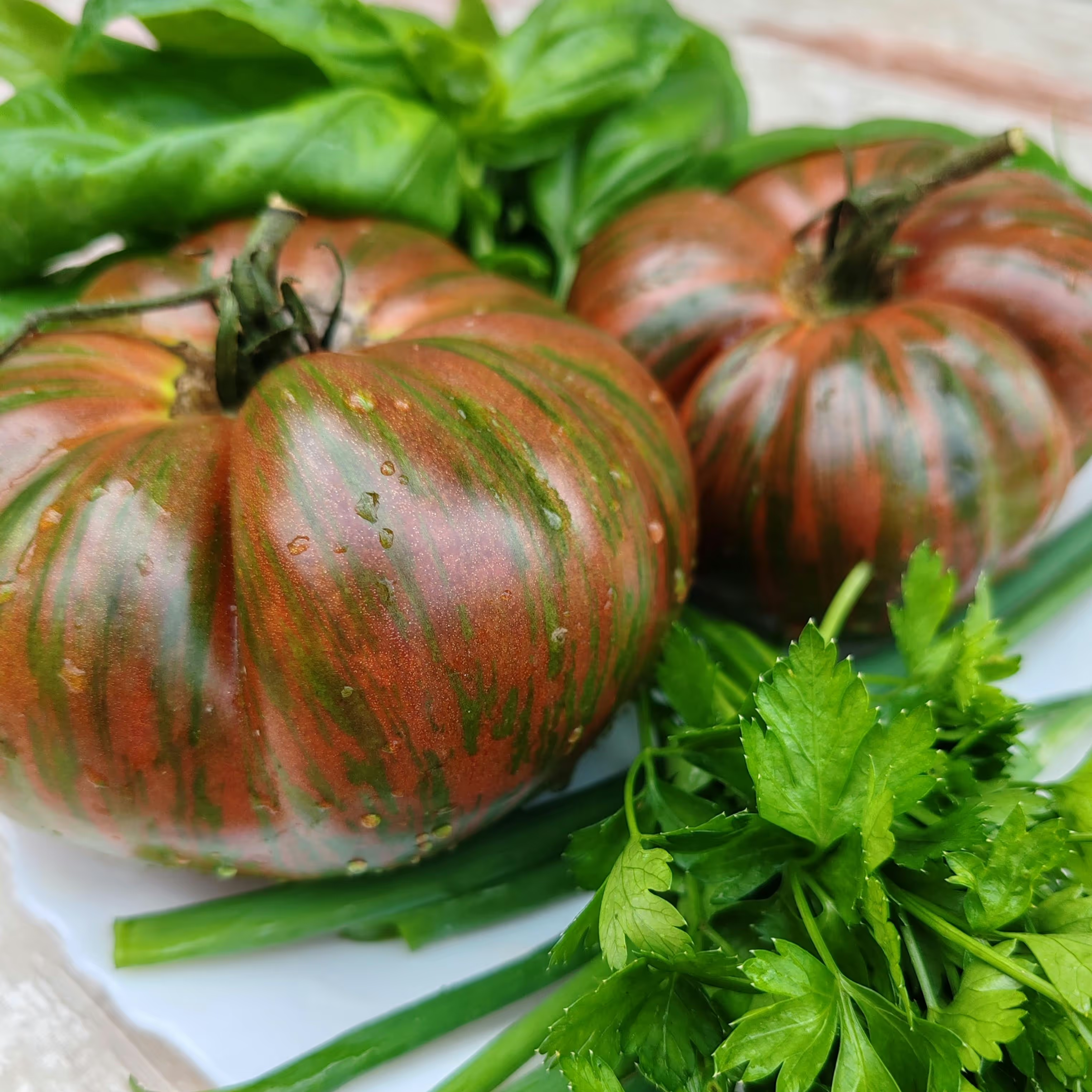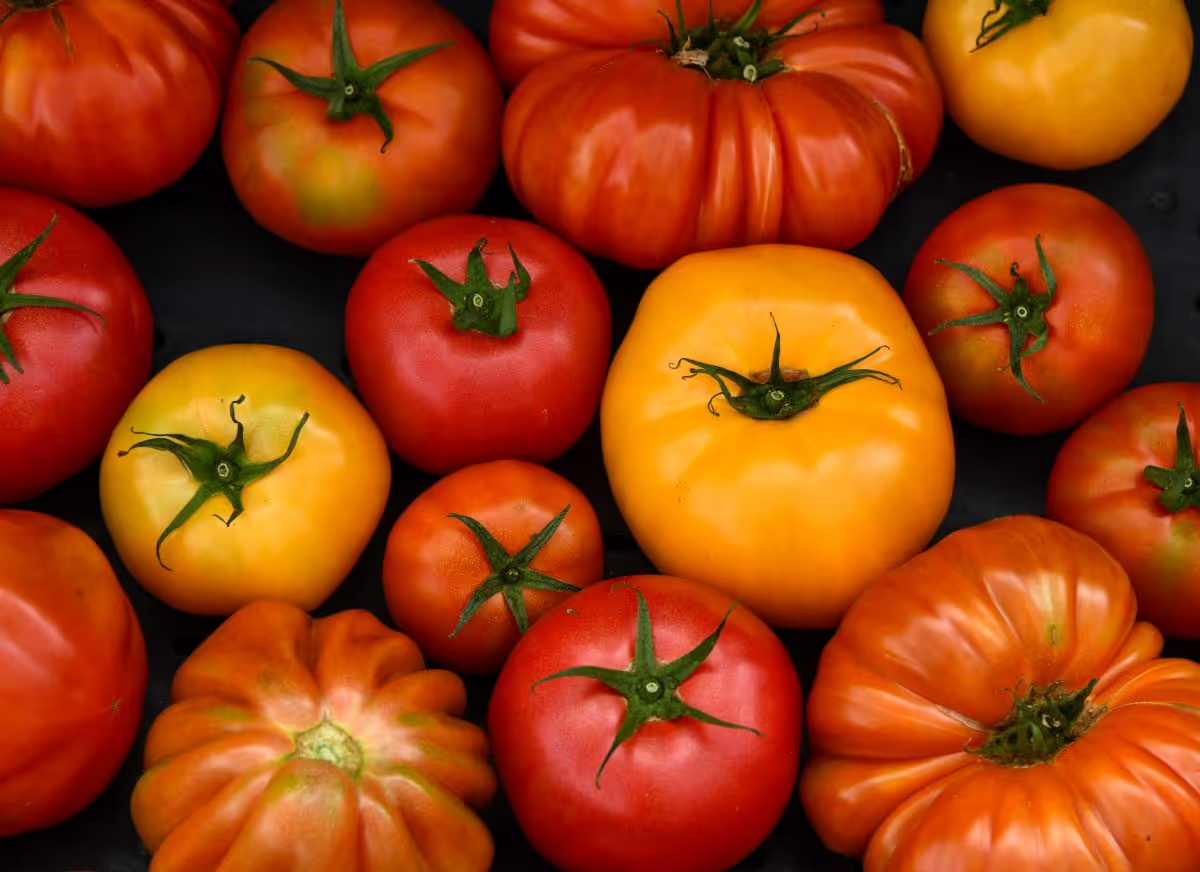What Does it Taste Like?
Tomatoes have a juicy, slightly acidic, and sweet flavor that varies depending on the type, ripeness, and growing conditions of the tomato. They also have a soft and fleshy texture that can be firm or tender, smooth or wrinkled, depending on how they are harvested and stored. Tomatoes come in many shapes, sizes, and colors, from tiny cherry tomatoes to large beefsteak tomatoes, and from bright red to yellow, green, purple, and even black.
Varieties we grow

Yellow Pear
These small, teardrop-shaped tomatoes have a mild, fruity sweetness with low acidity and a juicy bite. Their firm yet tender texture makes them perfect for fresh salads, snacking, and garnishing platters. Roasting or slow-roasting enhances their natural sugars, making them a great addition to pasta dishes, sauces, and preserves.

Orange Brandywine
With their deep golden-orange color and exceptionally sweet, fruity flavor, Orange Brandywines are a standout heirloom tomato. Their juicy flesh shines in sandwiches, caprese salads, and simple preparations with olive oil and salt.

Pink Berkeley Tie Dye
A strikingly striped heirloom tomato with a rich, balanced sweetness and tang, this tomato has dense, juicy flesh that holds up well in slicing. Ideal for slicing, sandwiches, fresh salsas, and vibrant summer salads.

Brandywine
Brandywine is a type of heirloom tomato that is known for its large, beefsteak-shaped fruits. It has a rich and complex flavor that is often described as sweet, tangy, and fruity, with a smooth and juicy texture that melts in the mouth. It has a distinctive aroma that is reminiscent of fresh tomatoes and herbs. Brandywine tomatoes are ideal for slicing and eating fresh, as they have a thin skin and a meaty flesh.

Sun Gold
These are orange cherry tomatoes that have a glossy and smooth skin and a round and slightly flattened shape. They are a hybrid variety that is known for its sweet, tangy, and tropical flavor. They have a thin skin and a juicy interior that bursts with flavor when bitten into. They are popular in salads and as snacks due to their juicy texture and sweet flavor. They are great for grilling, roasting, or making soups.

Oregon Star
These are large, red, paste-type tomatoes that have a firm, seedless, and nearly solid flesh. They have a mild and sweet flavor and a smooth and tender texture. They are ideal for slicing, peeling, or processing.
Why Should I Eat It?
Tomatoes are not only tasty, but also nutritious. They are rich in vitamin C, potassium, folate, and vitamin K, as well as antioxidants such as lycopene, beta carotene, and naringenin. These nutrients and compounds can help protect against various diseases, such as cancer, heart disease, and inflammation. Tomatoes are also low in calories and high in water and fiber, making them a great choice for weight management and hydration.
Tomatoes

July - October
Tomatoes are the red gems of summer, shining with their bright and beautiful color and their juicy and sweet flavor. They are not only pretty to look at, but also delicious to eat, and good for your health. Tomatoes are a member of the Nightshade family, which also includes eggplants, peppers, and potatoes. They’re incredibly versatile, and can be used in many different ways, from salads and sandwiches to sauces and soups.
Recommended Storage
How Do I Store It?
Short Term
Tomatoes can be stored in different ways, depending on their ripeness, quality, and intended use. Some of the best methods for storing tomatoes are:
- On the counter: This is the best way to store unripe or slightly ripe tomatoes, as they will continue to ripen and develop their flavor and color at room temperature. However, avoid direct sunlight, heat, or moisture, as they can cause tomatoes to spoil faster. Also, keep tomatoes away from other fruits and vegetables that produce ethylene gas, such as bananas, apples, and pears, as they can speed up the ripening process and make tomatoes overripe and mushy. Store tomatoes stem-side down, as this prevents air and moisture from entering the scar and causing rot. Check tomatoes daily and use them as soon as they are ripe and firm.
- In the fridge: This is the best way to store fully ripe or overripe tomatoes, as the cold temperature will slow down the ripening process and extend their shelf life. However, refrigerating tomatoes can also reduce their flavor and texture, as the cold can damage their cell membranes and make them mealy and bland. Therefore, only refrigerate tomatoes if you plan to use them within a few days, and bring them to room temperature before eating or cooking them. Store tomatoes in a plastic bag or container in the crisper drawer of the fridge, and avoid washing or cutting them until you are ready to use them.
Long Term
- Freezing: This is the best way to store tomatoes for long-term use, as freezing preserves their flavor and nutrients and prevents them from spoiling. However, freezing tomatoes can also change their texture, as the water in their cells expands and ruptures their cell walls, making them soft and watery. Therefore, only freeze tomatoes if you plan to use them for cooked dishes, such as sauces, soups, stews, and casseroles. To freeze tomatoes, wash and dry them, then peel and core them if desired. You can freeze them whole, halved, chopped, or pureed, depending on your preference and the recipe. Place them in a single layer on a baking sheet and freeze until firm, then transfer them to a freezer-safe bag or container and label with the date. Use frozen tomatoes within a year for best quality.
- Canning: This is another way to store tomatoes for long-term use, as canning preserves their flavor and nutrients and makes them shelf-stable. You can can them whole, halved, chopped, or pureed, depending on your preference and the recipe. Tomatoes are an acidic food, so you can use either the water bath or pressure canning methods here.
- Pickling: Pickling tomatoes makes them sour and crunchy and adds a tangy and spicy flavor to them. Whole cherry tomatoes are the best candidate for pickling, but romas or even unripe green tomatoes work well too.
- Dehydrating: Wash and dry tomatoes, then slice them thinly and evenly. You can dehydrate them in an oven, a dehydrator, or in the sun, depending on your preference and the weather. Place them in a single layer on a baking sheet, a dehydrator tray, or a mesh screen, and sprinkle with salt, herbs, or spices if desired. Dry them at a low temperature (around 140°F) for several hours, turning them occasionally, until they are crisp and leathery. Store dehydrated tomatoes in an airtight container in a cool, dark, and dry place for up to a year.
How Do I Cook It?
If you have the self-restraint to not just eat them all raw, then you have a lot of cooking techniques to choose from, such as grilling, frying, sautéing, roasting, broiling, stewing, and steaming. Cooking tomatoes can enhance their flavor and release more lycopene, but it can also reduce some of their vitamin C and other water-soluble nutrients. Therefore, it is good to enjoy tomatoes both raw and cooked, depending on your preference and the recipe. Some of the best methods for cooking tomatoes are:
- Grilling: Cut tomatoes in half and brush with olive oil, salt, pepper, and other seasonings. Grill over medium-high heat for about 5 minutes, turning once, until charred and soft. Grilled tomatoes are great for salads, sandwiches, or as a side dish.
- Frying: Slice tomatoes and coat with flour, egg, and bread crumbs. Fry in hot oil over medium heat for about 4 minutes per side, until golden and crisp. Fried tomatoes are a classic Southern dish that can be served with bacon, eggs, or gravy.
- Sautéing: Chop tomatoes and cook with garlic, onion, olive oil, salt, pepper, and herbs over medium-high heat, stirring occasionally, until soft and saucy. Sautéed tomatoes are perfect for pasta, rice, or as a base for other dishes.
- Roasting: Cut tomatoes into wedges and toss with olive oil, salt, pepper, and herbs. Roast in a preheated oven at 375°F for about 25 minutes, until caramelized and tender. Roasted tomatoes are delicious as a snack, a topping for bread, or a filling for pies or tarts.
- Broiling: Cut tomatoes into slices and arrange on a baking sheet. Sprinkle with cheese, breadcrumbs, salt, pepper, and herbs. Broil in a preheated oven for about 10 minutes, until cheese is melted and tomatoes are bubbling. Broiled tomatoes are a simple and cheesy appetizer or side dish.
- Stewing: Cut tomatoes into chunks and simmer with water, vinegar, sugar, salt, pepper, and spices over low heat, stirring occasionally, until thick and jammy. Stewed tomatoes are a sweet and tangy condiment that can be used for sandwiches, burgers, or meats.
What Goes Well With It?
- Basil: This herb is a classic partner for tomatoes, as they both belong to the same plant family and share some aroma compounds. Basil adds a fresh and peppery note to tomato dishes, such as salads, sauces, soups, and pizzas.
- Mozzarella: This cheese is another traditional companion for tomatoes, especially in the Italian caprese salad. Mozzarella provides a creamy and mild contrast to the acidic and sweet tomatoes, and they both benefit from a drizzle of olive oil and balsamic vinegar.
- Garlic: This pungent and aromatic ingredient enhances the flavor of tomatoes and adds a savory and spicy kick to tomato dishes, such as sauces, salsas, bruschettas, and curries.
- Olive oil: This healthy and flavorful fat brings out the best in tomatoes, as it helps to dissolve and distribute their fat-soluble nutrients and compounds, such as lycopene and carotenoids. Olive oil also adds a fruity and nutty note to tomato dishes, and helps to balance their acidity.
- Balsamic vinegar: This sweet and tangy vinegar complements the flavor of tomatoes and adds a depth and complexity to tomato dishes, such as salads, soups, and glazes. Balsamic vinegar also helps to brighten and intensify the color of tomatoes.
- Avocado: This creamy and buttery fruit pairs well with tomatoes, as they both have a high water content and a smooth texture. Avocado also adds a healthy dose of monounsaturated fats and fiber to tomato dishes, such as salads, sandwiches, and guacamole.
- Lemon: This citrus fruit adds a refreshing and zesty touch to tomato dishes, as it helps to cut through the richness and sweetness of tomatoes and enhance their flavor. Lemon also adds vitamin C and antioxidants to tomato dishes, such as soups, sauces, and dressings.
